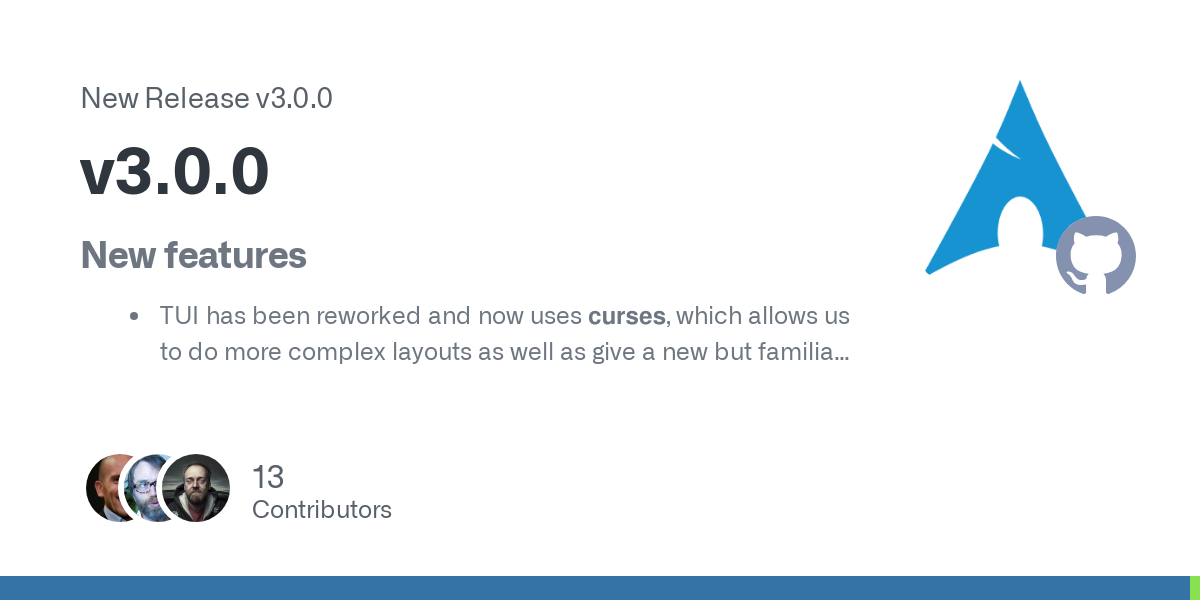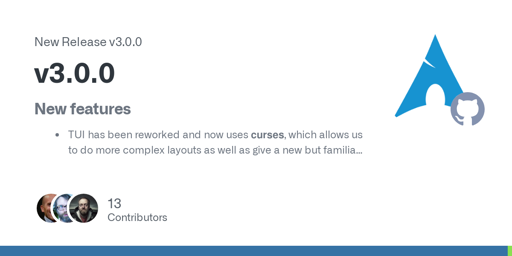Leaflet
- 224 Posts
- 182 Comments
No, you are never specifying to actually upgrade the package with the ‘u’ flag. Running
pacman -Sy archinstallwould upgrade the package, since it would first refresh the package cache then reinstall the latest version.Also, there’s not really a benefit to using 2 'y’s but it does add some extra stress to the package mirrors, so I would avoid doing that.
Current Arch ISO is from November 1, so you likely used the old version (unless you used
pacman -Syubefore you used in the installer).

 2·3 days ago
2·3 days agoFlatpak firefox stores that stuff in ~/.var/app/org.mozilla.firefox
- Flatpak, create a shell script to call the flatpak command and pass arguments
- If the app doesn’t work well as a flatpak or isn’t packaged, I would use distrobox
- If the app doesn’t work well in distrobox, I’d rpm-ostree install it
- If I’m feeling fancy, I might look into installing homebrew. But you need to do some workarounds with PATH and homebrew otherwise it can break things; Universal Blue includes these workarounds out of the box
Fedora Silverblue
- I like Gnome
- I like that Fedora adopts new technology quickly
- I like how it makes updates more reliable
- I like flatpak

 3·7 days ago
3·7 days agoPreferably the drivers and quirks of the hardware would all be patched upstream so that you don’t need to use a distro with the fixes patched in.

 231·9 days ago
231·9 days agoMac Mini doesn’t come with a keyboard. So unless you’ve owned an iMac or bought a keyboard separately, you won’t have that convenience.
That being said, I haven’t touched the power button on my Mac Mini since I got mine on the 8th.

 1·10 days ago
1·10 days ago“Boiling The Ocean” refers to the fact that this is what all the hackfest topics share in common: They’re all very difficult long-term efforts that we expect to still be working on for years before they fully bear fruit. A second, mostly incidental, connotation is that the the ocean (and wider biosphere) are currently being boiled thanks to the climate crisis, and that much of our work has a degrowth or resilience angle (e.g. running on older devices or local-first).
https://blogs.gnome.org/tbernard/2024/10/05/boiling-the-ocean-hackfest/

 11·11 days ago
11·11 days agoI’m just saying that I think it would be more accurate to group Gnome closer to Windows and KDE than MacOS. Especially if Dash to Dock and Appindicators are enabled, like in Ubuntu.
I could switch between Gnome, KDE, Windows, and most Linux DEs relatively easily, but MacOS’s feels quite different to me.

 5·11 days ago
5·11 days agoA good place to start is the “Water Cooler” section of the Fedora Discourse: https://discussion.fedoraproject.org/c/fun/8

 6·12 days ago
6·12 days agoI think a dev for Factorio discussed this issue on Brodie Robertson’s podcast.

 4·12 days ago
4·12 days agoBrand new Mac Mini, just came out today. It has a full year of warranty left.

 5·13 days ago
5·13 days agoMy HDMI tops out at 144hz, issue still present.

 3·13 days ago
3·13 days ago1440p at 170Hz with the DisplayPort. But I also tried going down to 60hz, but in that brief time I did that, that made the flickering issue even more apparent.
I hear that Gnome can struggle on touchscreens due to some GTK bugginess.
Plasma is probably a good bet since it has a dedicated touch friendly mode and is tested on the Steam Deck, which has a touch screen.
There’s third party Appimages. They also had a blog post discussing using Appimages for testing builds. If that gets done, I don’t see why they wouldn’t offer an official build.

 9·18 days ago
9·18 days agoI believe it’s an Apple Silicon limitation in their lower end chips.

 161·19 days ago
161·19 days agoOn iOS, I feel like doing things take a few extra taps and swipes than they would on Android.
But on the whole apps made for iOS feel higher quality. Even Google’s own apps are better on iOS. I feel like the problem is that Apple forces developers to adopt changes quickly, whereas Google lets apps use years old API versions.

 2·20 days ago
2·20 days agoFunny, FSR2 helps me a lot but FSR3’s frame generation does nothing for me.








The big thing it has going for it is that they set up btrfs snapshots out of the box so you can rollback if necessary.
They also do more automated testing than Arch so theoretically it should be more stable.